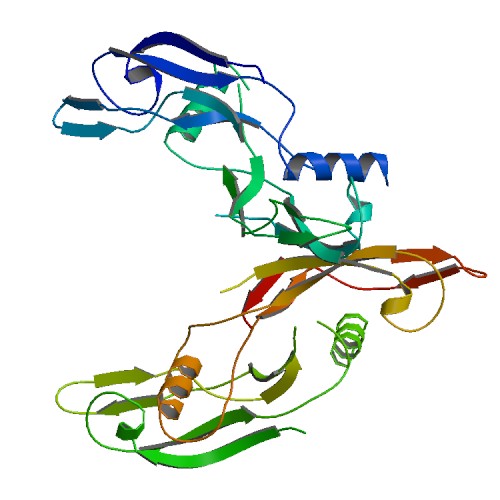
Bundle of nerves. Scientists at BrainStorm Cell Therapeutics hope to use patient-derived astrocyte-like cells to boost supplies of the neurotrophin GDNF in people with ALS. Image: Protein Data Bank.
In people with ALS, the motor nerves deteriorate leading to muscle weakness and ultimately paralysis. In hopes to stop this neurodegeneration in its tracks, researchers are looking towards substances called neutrophins including BDNF, GDNF, IGF-1 and VEGF to keep nerves healthy and plugged into muscles. But delivering these protective substances safely at the right place, at the right time and at the right dose has turned out to be extremely difficult to do. And, scientists remain unsure which one of these neurotrophins is the best choice for people with ALS to protect the motor nerves from further deterioration.
Studies suggest that moderate aerobic exercise such as stationary bicycling or treadmilling might have the potential to help keep muscles and nerves healthy longer in people with ALS by increasing levels of many of these protective substances in the brain and spinal cord. What’s more, a moderate workout might even help fight the disease by boosting energy supplies, removing damaged proteins and reducing inflammation.
Neurologists nevertheless remain reluctant to recommend specific exercise routines for their patients. There simply is not enough clinical evidence according to experts to indicate which routines are safe and offer the most benefit to people with ALS. New clinical trials promise to change that by putting exercise to the test in people with ALS.
Run, mouse, run
Exercise can keep your heart healthy and keep your spirits up. But according to experts, a short workout might do a lot more good for people with ALS. Certain forms of moderate aerobic exercise might help keep nerves plugged into muscles and protect them from destruction.
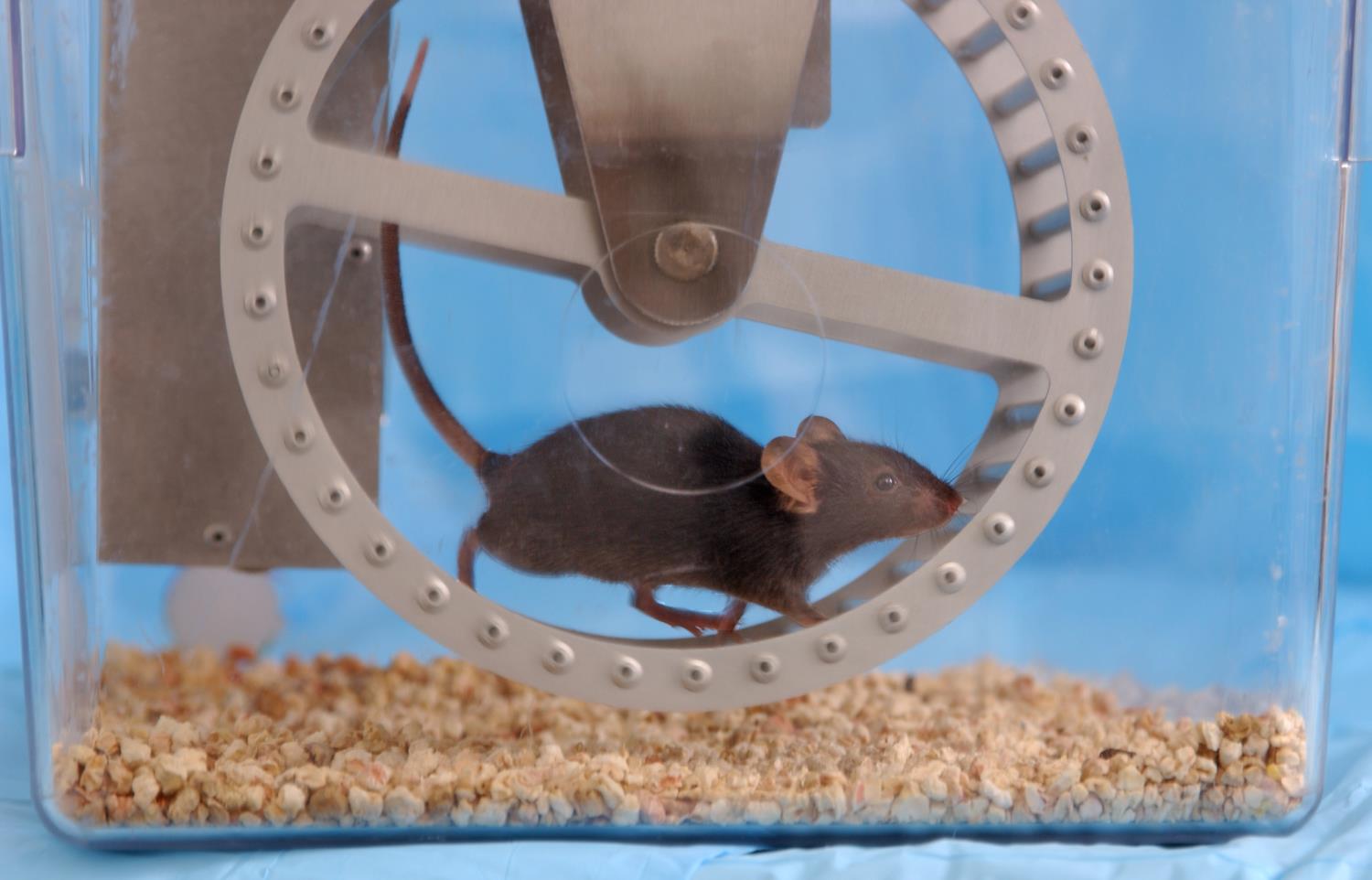
Mighty mouse. Researchers often study the underlying benefits of moderate aerobic exercise in mice by providing a running wheel. Image: Salk Institute of Biological Studies, San Diego.
Researchers first suspected that exercise might benefit people with ALS upon the discovery in the mid 1990s that a short aerobic workout boosted levels of neurotrophins - substances that protect motor neurons or trigger the growth of new motor neurons - in the brain. A team led by University of California Irvine neuroscientist Carl Cotman PhD reported in 1995 in rats that running for one week increased levels of BDNF in the brain more than two-fold. And, researchers from the Cajal Institute in Madrid reported in 2000 and 2001 that increased levels of the neurotrophin IGF-1 following moderate aerobic exercise helped to protect the brain in rats from injury or neurodegenerative disease.
Scientists subsequently discovered that moderate aerobic exercise increased circulating levels of a number of neurotrophins in people including those with multiple sclerosis or a spinal cord injury.
Encouraged by the ability of short aerobic workouts to boost neuroprotective mechanisms, researchers in the early 2000s tested ALS mice to determine whether or not such routines could help slow down the disease. In 2003 and 2005, scientists reported that running moderately increased the lifespan of ALS mice. And, in 2009, scientists from the Université de Paris Descartes found that swimming significantly delayed clinical onset and dropped losses of motor neurons in the spinal cord of ALS mice by nearly 50%.
The power of exercise
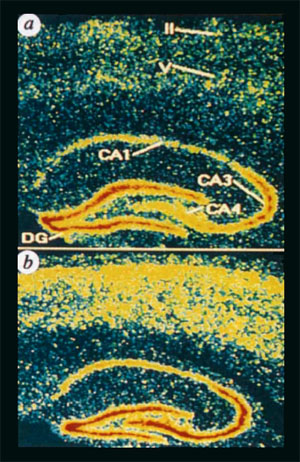
Growth spurt. Scientists discovered that moderate exercise induces the production of protective factors in the CNS. Here, the levels of BDNF are shown (yellow, red) in the brain of an exercised (b) vs. non-exercised (a) mouse. Adapted from Neeper, S.A. et al. (1995), Nature. Courtesy of Nature Publishing Group. All rights reserved.
Researchers however suspect that moderate aerobic exercise might have the potential to do much more to keep the motor nerves healthy in people with ALS. Exercise may help keep the power on in the motor nerves by boosting levels of oligodendrocytes: critical cells in the brain and spinal cord that are thought in part, to supply critical energy-making ingredients to mitochondria keeping the energy flowing in distal axons and nerve terminals. Reporting in 2011, scientists from the University of California in Los Angeles found that mice that frequented the running wheel for one week boosted numbers of oligodendrocyte precursors called NG2+ cells more than two-fold in the spinal cord. And, in 2009, scientists from the Université de Paris Descartes found that ALS mice which swam regularly maintained near healthy levels of spinal cord oligodendrocytes compared to unexercised mice which lost nearly a third of their oligodendrocytic populations.
What's more, exercise might keep neuroinflammation in check. Researchers at the Université de Paris Descartes reported in 2009 that swimming regularly dropped levels of activated astrocytes in ALS mice to nearly those of healthy mice – reducing levels of potentially damaging inflammatory cytokines in the spinal cord. And, scientists at the University of Illinois in Urbana reported in 2011 that providing access to a running wheel increased levels of microglia producing IGF-1 more than two-fold in healthy mice suggesting that moderate aerobic exercise might help push microglia from the neurotoxic to the neuroprotective mode.
“The potential effects of exercise are diverse,” says Johns Hopkins University School of Medicine Neurologist Nicholas Maragakis MD. “That’s what makes exercise so appealing.”
And, these potential benefits might just be the tip of the iceberg. A moderate aerobic workout according to a recent study in mice might even switch on intracellular vacuum cleaners within the motor nerves, reducing inflammation. Called autophagosomes, these mini Hoovers could help keep levels of neuronal destruction down by swallowing up aggregated proteins and malfunctioning mitochondria that accumulate during the course of the disease - dropping levels of reactive oxygen species (ROS) that further deteriorate the motor nerves. Looking ahead, the Baylor College of Medicine team hopes to evaluate whether or not this so-called exercise-induced autophagy could help protect against neurodegenerative disease.
"We do know that autophagy is likely a protective mechanism against these diseases," says Baylor College of Medicine internist Beth Levine MD who led the study. "Increasing autophagy may be a strategy to treat them."
Of mice to men
Translating these moderate aerobic workouts into specific routines for people with ALS however has been extremely challenging to do. And, the implementation of physical exercise into routine practice remains hotly debated and extremely controversial.
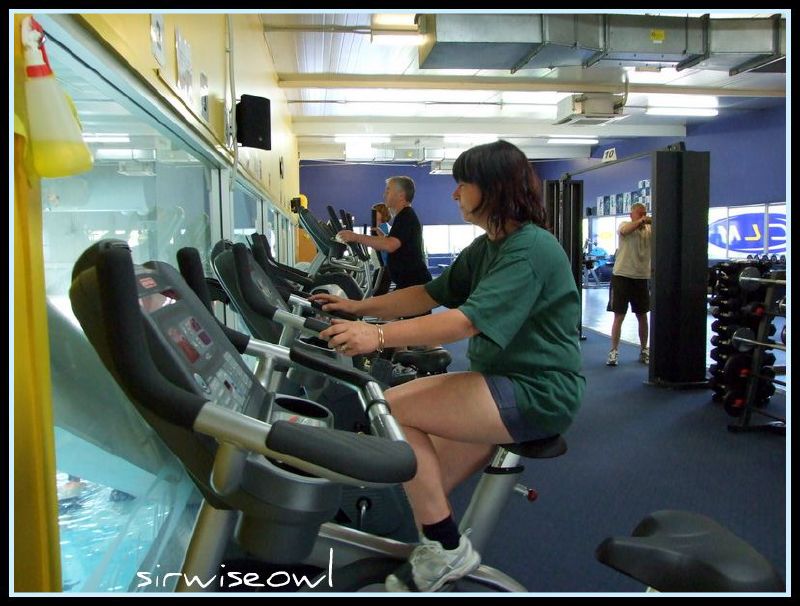
Spinning wheels. A growing number of researchers suspect that moderate aerobic exercise such as stationary bicycling might be helpful to people with ALS. But the use, the intensity and the duration of such routines remain controversial. Image: sirwiseowl, Flickr.
Some neurologists worry that regular exercise could speed up the progression of the disease by turning up the production of reactive oxygen species (ROS), potentially damaging weakening muscles and increasing inflammation of the connecting nerves.
But a growing number of neurologists argue that physical inactivity could expose people with ALS to even greater health risks. And, exercise in moderation could bring the benefits of exercise while minimizing the risk of worsening their condition.
“I do think that mobility is important,” says Johns Hopkins neurologist Nicholas Maragakis MD. “I usually tell them to exercise on an every other day basis. [But] I don’t want them to be fatigued or have any muscle pain following an exercise regimen.”
Most clinical studies on the books that evaluate the benefits and risks of exercise comes from studies that involve people with other neuromuscular diseases – particularly complications due to polio - not ALS.
“There is no evidence that exercise is harmful to people with ALS,” says Oxford University neurologist Martin Turner MA PhD MRCP.
Many neurologists therefore find themselves in a Catch-22. Exercise could be helpful and could be good for the overall wellness of their patients. But how much exercise is enough but not too much? What kinds of workouts should they do?
With existing randomized controlled exercise studies extremely limited and conducted in fewer than 25 people with ALS, neurologists are unable to figure out which kinds of exercise are safe and offer the most benefits at the lowest risk for their patients.
“We need to know which type of exercise at what duration and intensity could be protective,” explains INSERM – Strasbourg neuroscientist Luc Dupuis PhD.
We can work it out
University of Lisbon physician Anabela Pinto MD PhD grew frustrated in the mid 1990s that she could not do more for her patients with ALS. Noninvasive ventilation appeared to extend survival but did not improve their quality of life or slow down their disease. In hopes to change that, she began to introduce exercise into their daily routine.
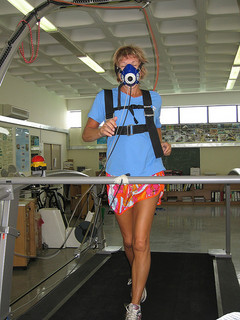
Sweet oxygen. Experts perform cardio pulmonary exercise testing (CPET) to determine the maximum output of oxygen (VO2 max): a critical benchmark that indicates to researchers the point at which muscles could be overworked or damaged. Image: Salem Elizabeth, Flickr.
Reporting in 1999, the University of Lisbon physicians found that a group of 8 people with ALS who exercised showed significant reductions in decline of breathing abilities after one year of rehabilitation (FVC, P < 0.002). 20 people with ALS participated in the controlled clinical trial.
The strategy her Santa Maria Hospital -based team developed is loosely based on a typical cardiac stress test. Exercise either on a cycle ergometer or a treadmill ramped up to 60-65% oxygen output (about 70-75% heart rate) for about 10-20 minutes - sufficient intensity to keep weakening muscles moving but not overworking or damaging them. Workouts are typically scheduled three times per week.
The idea: By performing aerobic exercise regularly for a short period of time, the team hopes to keep fast-twitch muscles critical to maintain optimal breathing rate and to power rapid motions moving; muscles which are especially vulnerable to atrophy in people with ALS.
In subsequent years, the team implemented this supervised exercise program in their Lisbon-based clinic. Non-invasive ventilation and body-weight support systems are provided if needed.
“Our current practice is to include exercise throughout the clinical evolution of the disease,” says Pinto.
Reporting the first results of her latest exercise study at the 2011 ALS/MND meeting in Australia last December, the University of Lisbon team found that people with ALS on this supervised exercise regimen showed significant signs of reduced functional decline (ALS-FRS) and increased survival post-rehabilitation (p = 0.04) over a one year period. 40 patients participated.
Now, the Santa Maria Hospital-based team is working hard to adapt these exercises for home use. And at the same time, the team is adjusting these routines to accommodate people with ALS that might have trouble adhering to such regular workouts due to deficits in executive function, estimated to affect as many as 50% of people with the disease.
“I am really interested in making this [exercise] program available to as many patients as possible,” says Pinto.
But the Neuromuscular Unit at Santa Maria Hospital is small. The team’s aerobic exercise routines have only been tested in a few people with ALS. Larger studies are needed according to experts to implement specific therapeutic workouts into routine practice.

NMJ Unplugged. In people with ALS, neuromuscular junctions can become unstable leading to the nerves being unplugged from muscles ultimately resulting in paralysis. Exercise may help stabilize these connections according to experts. John Wildgoose, Wellcome Images.
Now, a group of neurologists led by Johns Hopkins University School of Medicine neurologist Nicholas Maragakis MD are stepping up to the plate by launching a clinical trial to evaluate the benefits of exercise in people with ALS. The clinical trial, which will take place over six months in four centers in the US, will put three forms of moderate exercise to the test in people with ALS: stationary bicycling (aerobic exercise), weightlifting (resistance exercise) and stretching (the standard of care). Patients will be monitored for improvements in muscle strength/fatigue, signs of reduced functional decline and quality of life. About 60 people with possible, probable or definite ALS are expected to participate.
“The trial's power is to really study the safety and tolerability of exercise [in people with ALS],” explains Johns Hopkins School of Medicine neurologist Nicholas Maragakis MD. “I think that will go a long way.”
Researchers however anticipate that workouts that experts ultimately develop for people with ALS will extend well outside the exercise gym. By understanding the underlying mechanisms behind the benefits of these workouts, scientists hope to gain insight into the underlying mechanisms of this exercise-based neuroprotection to help them develop more effective medicines to fight the disease.
Scientists at Johns Hopkins School of Medicine hope to identify the underlying benefit of any workout found to be helpful in a future clinical trial by measuring levels of circulating neurotrophins and possibly looking for changes in muscle fiber composition in people with ALS following exercise.
The findings according to Luc Dupuis PhD, also at Germany's University of Ulm, could help scientists figure out how to fight one of the hardest aspects of the disease: denervation, when the motor nerves become unplugged from muscles leading to weakness and paralysis.
“During exercise, neuromuscular junctions are strengthened and stabilized,” explains Dupuis. “Understanding what really happens during exercise might lead to a therapeutic strategy to treat ALS.”
References - Clinical Studies
Lui, A.J. and Byl, N.N. (2009) A systematic review of the effect of moderate intensity exercise on function and disease progression in amyotrophic lateral sclerosis. Journal of Neurological Physical Therapy 33, 68-87. Abstract | Full Text (Subscription Required)
Dalbello-Haas V, Florence JM, Krivickas LS. (2008) Therapeutic exercise for people with amyotrophic lateral sclerosis or motor neuron disease. Cochrane Database of Systematic Reviews 2, CD005229. Abstract | Full Text (Subscription Required)
Rojas Vega, S., Abel, T., Lindschulten, R., Hollmann, W., Bloch, W. and Strüder, H.K. (2008) Impact of exercise on neuroplasticity-related proteins in spinal cord injured humans. Neuroscience 153(4), 1064-1070. Abstract | Full Text (Subscription Required)
Bello-Haas, V.D., Florence, J.M., Kloos, A.D., Scheirbecker, J., Lopate, G., Hayes, S.M., Pioro, E.P. and Mitsumoto, H. (2007) A randomized controlled trial of resistance exercise in individuals with ALS. Neurology 68, 2003-2007. Abstract | Full Text (Subscription Required)
Gold, S.M., Schulz, K.H., Hartmann, S., Mladek, M., Lang, U.E., Hellweg, R., Reer, R., Braumann, K.M. and Heesen C. (2003) Basal serum levels and reactivity of nerve growth factor and brain-derived neurotrophic factor to standardized acute exercise in multiple sclerosis and controls. Journal of Neuroimmunology 138(1-2), 99-105. Abstract | Full Text (Subscription Required)
Drory VE, Goltsman E, Reznik JG, Mosek A, Korczyn AD. (2001) The value of muscle exercise in patients with amyotrophic lateral sclerosis. Journal of Neurological Sciences 191, 133-137. Abstract | Full Text (Subscription Required)
Pinto, A.C., Alves, M., Nogueira, A., Evangelista, T., Carvalho, J., Coelho, A., de Carvalho, M. and Sales-Luís, M.L. (1999) Can amyotrophic lateral sclerosis patients with respiratory insufficiency exercise? Journal of Neurological Sciences 169, 69-75. Abstract | Full Text (Subscription Required)
References - Preclinical Studies
He, C. et al. (2012) Exercise-induced BCL2-regulated autophagy is required for muscle glucose homeostasis. Nature 481, 511-5. Abstract | Full Text (Subscription Required)
Kohman, R.A., Deyoung, E.K., Bhattacharya, T.K., Peterson, L.N. and Rhodes, J.S. (2011) Wheel running attenuates microglia proliferation and increases expression of a proneurogenic phenotype in the hippocampus of aged mice. Brain, Behavior and Immunity doi 10.1016/j.bbi.2011.10.006. Abstract | Full Text (Subscription Required)
Krityakiarana, W. et al. (2010) Voluntary exercise increases oligodendrogenesis in the spinal cord. International Journal of Neuroscience 120(4), 280-290. Abstract | Full Text
Nave, K.A. (2010) Myelination and the trophic support of long axons. Nature Reviews Neuroscience 11(4), 275-283. Abstract | Full Text (Subscription Required)
Deforges, S., Branchu, J., Biondi,O., Grondard, C., Pariset, C., Lécolle, S., Lopes, P., Vidal, P.P., Chanoine, C. and Charbonnier, F. (2009) Motor neuron survival is promoted by specific exercise in a mouse model of amyotrophic lateral sclerosis. Journal of Physiology 587, 561-572. Abstract | Full Text
Kaspar, B.K., Frost, L.M., Christian, L., Umapathi, P. and Gage, F.H. (2005) Synergy of insulin-like growth factor-1 and exercise in amyotrophic lateral sclerosis. Annals of Neurology 57(5), 649-655. Abstract | Full Text (Subscription Required)
Kirkinezos, I.G., Hernandez, D., Bradley, W.G. and Moraes, C.T. (2003) Regular exercise is beneficial to a mouse model of amyotrophic lateral sclerosis. Annals of Neurology 53(6), 804-807. Abstract | Full Text (Subscription Required)
Carro, E., Trejo, J.L., Busiguina, S. and Torres-Aleman, I. (2001) Circulating insulin-like growth factor I mediates the protective effects of physical exercise against brain insults of different etiology and anatomy. Journal of Neuroscience 21(15), 5678-5684. Abstract | Full Text (Subscription Required)
Carro, E., Nunez, A., Busiquina, S. and Torres-Aleman I. (2000) Circulating Insulin-like growth factor 1 mediates effects of exercise on the brain. Journal of Neuroscience 20, 2926-2933. Abstract | Full Text (Subscription Required)
Itoh, H., Ohkuwa, T., Yamamoto, T., Sato, Y., Miyamura, M. and Naoi, M. (1998) Effects of endurance physical training on hydroxyl radical generation in rat tissues. Life Sciences 63(21), 1921-1929. Abstract | Full Text (Subscription Required)
Neeper, S.A., Góauctemez-Pinilla, F., Choi, J. and Cotman, C. (1995) Exercise and neurotrophins. Nature 373, 109. Abstract | Full Text (Subscription Required)
Further reading
Lopes de Almeida, J. P., Silvestre, R., Pinto A. C., and de Carvalho, M. (2012) Exercise and amyotrophic lateral sclerosis. Neurological Sciences 33, 9-15. Abstract | Full Text (Subscription Required)
Ashworth, N.L., Satkunam, L.E. and Deforge, D. (2012) Treatment for spasticity in amyotrophic lateral sclerosis/motor neuron disease. Cochrane Database of Systematic Reviews 2, CD004156. Abstract | Full Text (Subscription Required)
Patient Resources
Trial of Resistance and Endurance Exercise in Amyotrophic Lateral Sclerosis (ALS) ALSTDI | Website | Contact